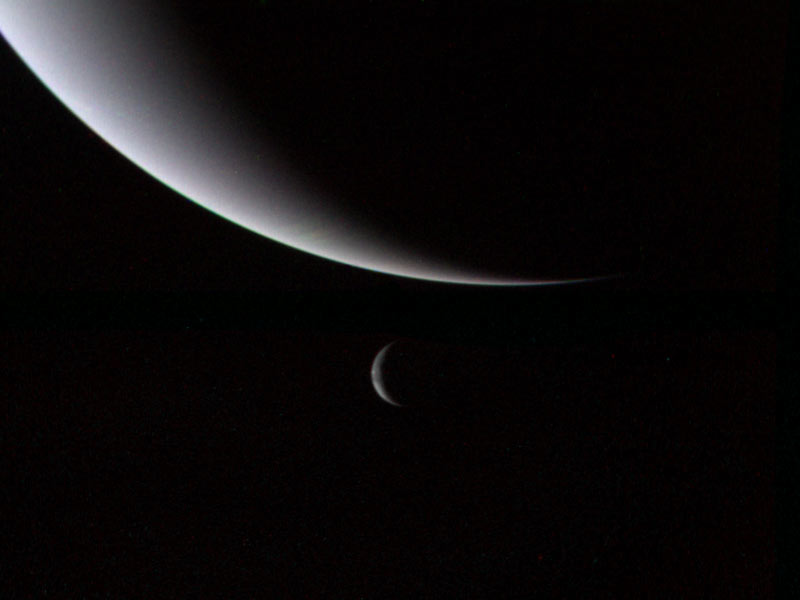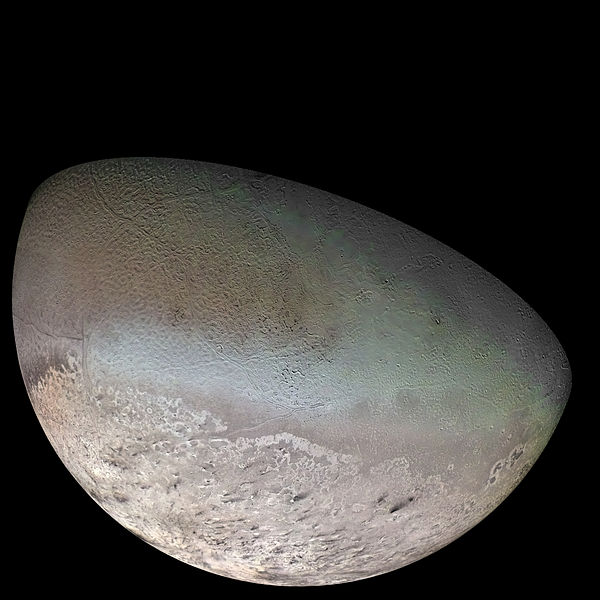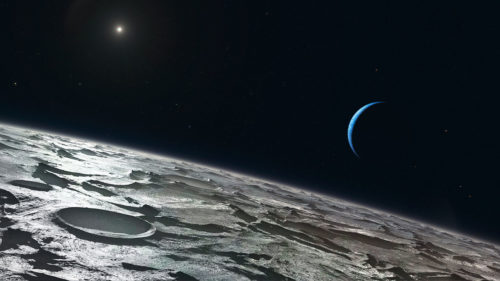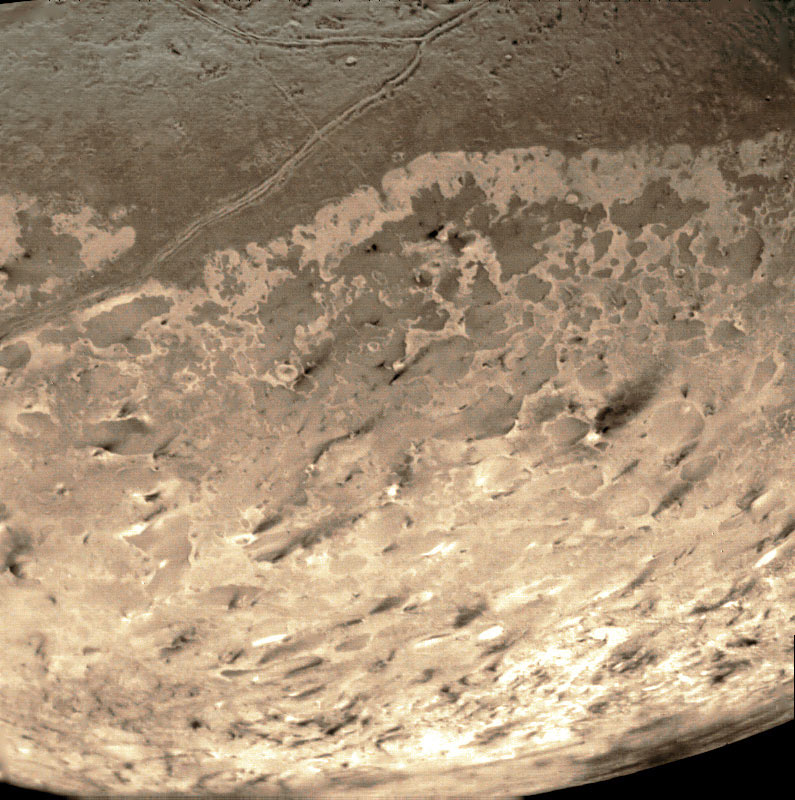
Twenty-five years ago, this week, humanity braced itself for its last, first-time, close-up glimpse of a new planet in the 20th century. NASA’s Voyager 2 spacecraft, launched in August 1977, had already conducted a breathtaking exploration of Jupiter and Saturn—together with its twin, Voyager 1—and had undertaken our species’ first visit to Uranus. In readiness for the Uranus and Neptune rendezvous, a conference in Pasadena, Calif., in February 1984, allowed scientists to look at what was known about the two mysterious planets and identify a comprehensive series of observations about them. Although a reasonable amount of valuable data existed about Neptune, the enormous quantity of new information which would flow back to Earth in August 1989 enriched our understanding of this strange, distant world. As described in yesterday’s AmericaSpace history article, the observations of Neptune turned up many more questions than answers, as would its close passage by one of the Solar System’s most enigmatic moons: Triton.
After hurtling over Neptune’s north pole, Voyager 2 turned south, hurtling through the ring plane, in the direction of Triton, which had grown steadily larger over the past 15 months. By late August 1989, the large moon covered more than half of the spacecraft’s narrow-angle lens. Despite its size, it became clear that Triton was actually far smaller than had been anticipated: only 1,680 miles (2,700 km) in diameter, it was about three-quarters the size of our Moon and the Solar System’s seventh-largest natural satellite. Pre-Voyager estimates of its mass, based upon the amount of reflected sunlight, had produced erroneous results. “Triton has been shrinking as we approached,” joked Brad Smith, the head of Voyager 2’s imaging team, “until we feared that by the time we arrived, it might be gone!”
These incorrect estimates originated in the early 1980s, when ground-based infrared observations revealed the spectroscopic signature of nitrogen gas and ice on Triton’s frozen surface. This led some investigators to wonder if the moon’s diameter and mass were smaller than originally thought. Triton was discovered by William Lassell in October 1846, only three weeks after Neptune itself, although it remained “nameless” until the early years of the 20th century. One of its peculiarities, first noted by Lassell, was a highly-inclined, retrograde orbit, which caused it to circle Neptune “backwards” (or, more correctly, in a clockwise direction when viewed from the north). This led to a number of suggestions about Triton’s origin and evolution.

It has long been suspected that Pluto, which seems to be compositionally similar to Triton, is an ancient moon of Neptune which escaped its gravitational clutches. When astronomers began to ponder the retrograde orbit, they speculated that some ancient event had sent Pluto careening away into space and disturbed the path of Triton around Neptune. However, since the discovery of the “Kuiper Belt”—a broad swarm of debris beyond Neptune, which might harbor chunks of primordial material from the Solar System’s formation—it is generally thought that both Pluto and Triton may originate from this region. It is particularly noteworthy that the six “new” moons found by Voyager 2 occupy “well-behaved,” equatorial orbits, and unless they formed significantly later than the hypothetical ancient event their paths would be expected to have been similarly disturbed. This makes a Kuiper Belt origin for Triton more likely.
In fact, the sizes of the 14 moons found to date—Triton, Nereid, six others detected by Voyager 2, and six more identified earlier this century by ground-based astronomers and by the Hubble Space Telescope (HST)—offer persuasive evidence that some catastrophic sequence of events may have occurred in Neptune’s distant past. Unlike the other three gas giants, the planet does not have a system of “mid-sized” moons, with diameters ranging from 300-1,000 miles (500-1,600 km). Triton, which consumes about 99.5 percent of all the mass in orbit around Neptune, is by far the largest and falls “above” the upper limit for this breed of moons, whilst Nereid and the others fall short of its lowermost qualifying size. Some astronomers have suggested that the planet did once possess a family of mid-sized moons, but that the arrival of Triton either scattered them, destroyed them or ejected them from the Neptunian system altogether. In support of this possibility, Triton lies about 15 Neptune radii, or 230,000 miles (370,000 km), from the planet’s center, which happens to be squarely in the middle of the domain occupied by the mid-sized moons of Jupiter, Saturn, and Uranus. If such an event did happen, the debris from the mid-sized moons may have coalesced into the “second generation” seen today.
One of the moons found by Voyager 2 which could form part of this second-generation family is Proteus, which measures 260 miles (420 km) in diameter, close to the threshold for being classified as mid-sized. It is roughly the same size as Saturn’s moon, Mimas, or Uranus’ moon, Miranda, and is actually larger than Nereid. However, it had remained unseen from Earth, because it was too close to Neptune and thus lost in its glare. Yet, unlike Mimas or Miranda, Proteus is a “primitive” body: dark in color, heavily cratered, and of an irregular shape. Some planetary dynamicists have argued that potato-like Proteus is about as large as an irregular moon can get before gravity starts to pull it into a sphere. Its shape is often regarded as an indicator that it has not undergone thermal processing through much of its history, with limited geological upheaval, although it apparently suffered massive meteoroid bombardment on a grand scale in the distant past. Voyager 2 did not fly close to Proteus, and even its best pictures revealed little in the way of surface features—just a few blurred craters, trough-like depressions, and tall, forbidding ridges.
If Triton was a “late” arrival to the Neptunian system, the origins of Nereid remain more of a mystery. Some researchers have argued that if it was not thrown into its eccentric orbit by the arrival of Triton, then it is probably a captured asteroid, even though its path is not retrograde. Voyager 2 saw Nereid is a distant blob—the spacecraft passed no closer than 2.9 million miles (4.7 million km) from the moon—and was unable to resolve any detail. Indeed, after observing it intently for 12 full days, it was not possible to even determine Nereid’s rotation rate, so indistinct was its surface. Certainly, the moon’s shape and highly eccentric orbit is consistent with a captured body. Nereid orbits Neptune as close as 807,780 miles (1.3 million km) and as far as 5.9 million miles (9.6 million km). Voyager 2 was unable to pinpoint its exact shape, but it is not spherical, which again hints at an asteroidal origin. However, recent spectroscopic observations revealed the presence of dirty water-ice on its surface, suggestive of it being an “original,” pre-Triton moon of Neptune.

For Voyager 2, these mysteries were eclipsed by its flyby of Triton, which came a few hours after closest approach to the planet itself. Image motion compensation techniques, trialed at Uranus, came into their own and held the spacecraft sufficiently steady to acquire some of the most astonishing, map-quality photographs of the entire mission. Moving at 39,600 mph (63,730 km/h), Voyager 2 passed within 24,730 miles (39,800 km) of Triton’s center, revealing a world of profound complexity and a spectacular conclusion to a 12-year, four-planet “Grand Tour.”
Two minutes after closest approach, the spacecraft’s particles and ultraviolet sensors observed Triton pass in front of the star Gomeisa, in the constellation of Canis Minor, and later our own Sun, which allowed for details of the moon’s composition to become apparent. At 37 Kelvin, it has the coldest known surface in the Solar System, although temperatures climbed slightly higher to 93 Kelvin at the top of its 500-mile-deep (800-km) atmosphere. This incredibly thin mixture can only really be termed an “atmosphere” in the loosest sense of the world. Its low pressure is just one-70,000th of the surface pressure on Earth and is very nearly vacuum and only barely capable of sustaining thin nitrogen ice clouds and haze. These clouds “hang” about eight miles (13 km) above Triton’s surface, whilst the haze may constitute a sort of photochemical “smog.”
The main source of Triton’s atmospheric gases seems to be the slow evaporation of nitrogen, methane, carbon monoxide, carbon dioxide, and water, which exist as ices on its frozen surface. Of these, nitrogen is the most abundant, constituting about 99 percent of the atmosphere. Winds, presumably caused by the movement of these gases, are thought to carry fine dust particles and deposit them on the surface up to 30 miles (50 km) away. Ground-based observations from 1981 also suggested that atmospheric ice or frost periodically showers Triton’s surface with frozen nitrogen “snow.” Such large quantities of surface ice cause the moon to reflect 85-95 percent of the sunlight which strikes it; by comparison, our Moon reflects, on average, a mere 11 percent. This variation in Triton’s reflectivity is caused by its highly inclined orbit around Neptune, which causes its seasons to change quite considerably in their severity.
Voyager 2’s highest resolution images covered only a third of Triton’s surface and revealed a curious, ubiquitous, greenish terrain, which was nicknamed “cantaloupe,” due to its textural similarity to the ridged skin of a cantaloupe melon. Visually, this took the appearance of a series of roughly circular, interlocking depressions, known as “cavi,” each about 15-18 miles (25-30 km) across. The cantaloupe terrain is criss-crossed by long, interconnected ridges, which are thought to have been caused by one or more epochs of melting and near-complete resurfacing of Triton. Speculations continues to abound that the heat source for this melting comes most likely from the tremendous heat associated with the moon’s capture by Neptune and the subsequent circularization of its orbit. It is quite possible that this melting might have kept Triton’s surface in a liquid state for up to a billion years after its capture and perhaps created the right conditions for the development of tiny, microbial life.

The immense forces associated with Triton’s capture by Neptune are also thought to be responsible for substantial crustal fractures identified by Voyager 2. These forces caused localized melting of the moon’s surface, which left large, smooth regions or filled basins with lava-like flows, probably of water ice. At a much later date, “outgassing” in the form of volcanic vents or other subsurface processes led to the gradual formation of its thin atmosphere. Some scientists believe that Triton had a thick atmosphere during its formative period, but that eventually temperatures close to its surface began to cool and that this led to the development of surface ice to reflect away the already-weak sunlight and triggering a significant temperature decline. More surface ice formed, overlying large sections of the cantaloupe terrain, and temperatures to such a point that elements of the tenuous atmosphere froze and formed extensive polar caps.
Voyager 2 revealed the southern polar cap to be strange, pinkish color, possibly due to the evaporation of methane and nitrogen ice. Beyond the edge of the cap was a bluish crustal area, probably composed of water ice, which was pockmarked with interlocking cellular features, similar to melted chain mail. Crossing this wasteland were vast canyons and long, straight ridges with central furrows, perhaps representative of subsurface material having been pushed up through crustal fractures. Most of the features seen by Voyager 2 are believed to be solid water ice, which is frozen so hard that it has the consistency of rock at these frigid temperatures. The largest of its visible craters, a monster named “Mazomba,” measures 16.8 miles (27 km) in diameter, although Triton has relatively few craters, indicative of the relative youth of its present surface.
It has been argued that liquid might still be emerging, cryovolcanically, from the depths of Triton, freezing onto the surface and obliterating all but the very youngest craters. Volcanism had previously been seen only on Earth and, in 1979, on Jupiter’s moon, Io, but in August 1989 icy plumes of geysers and their after-effects were clearly detected on Triton. Voyager 2’s imagery revealed large quantities of dark material and a “powder” of rock particles, transported up to 30 miles (50 km) across the surface by the prevailing winds. The spacecraft’s photographs showed dark smudges, caused by this material, which ran across the southern polar ice cap. Detailed analysis of two plumes, nicknamed “Hili” and “Mahilani,” revealed that they changed over a 90-minute period and that winds close by blew at more than 30 mph (50 km/h).
Following its visit to Triton, Voyager 2’s exploration of the Neptunian system came to an end. The spacecraft continued to make observations until early October 1989, after which the giant planet’s gravity “bent” its trajectory inexorably southward and a new mission. For the remainder of its life, Voyager 2 would embark on an exploration to depart the Solar System forever and identify the very edge of the Sun’s realm. A quarter-century later, that mission continues to inspire and astound us.
This is part of a series of history articles, which will appear each weekend, barring any major news stories. Next week’s article will focus on the 30th anniversary of Mission 41D, the maiden voyage of Shuttle Discovery, in August 1984.
Want to keep up-to-date with all things space? Be sure to “Like” AmericaSpace on Facebook and follow us on Twitter: @AmericaSpace



